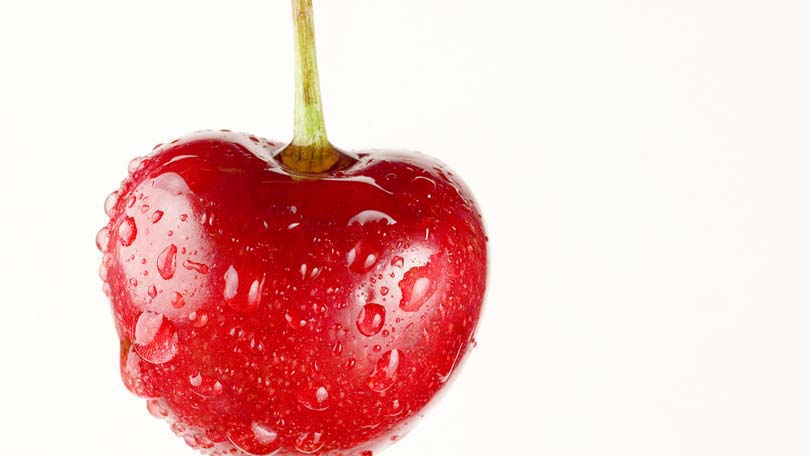With its cheery shape and color, as well as its sensual flavor and fragrance, the cherry enjoys universal popularity for its aesthetic and culinary value. Its original name in Latin meant “for the birds” for obvious reasons, but not only birds enjoy their beautiful blossoms and versatile fruit.
The cherry is one of the oldest cultivated fruits. Records dating back to 300 BC document the first cherry crops, and cherries were growing in the wild for many years prior to those earliest orchards.
Ninety percent of commercial cherry crops are located in North America, with the Michigan town of Travese, home of the annual National Cherry Festival, hailed has the “cherry capital of the United States.” Other prolific cherry producers include California, Oregon, and Washington.
Because of irrigation costs and the cherry’s proneness to damage from extreme weather conditions, the cherry is a comparably expensive fruit. Despite its costliness, it continues to be in very high demand.
While the cherry boasts myriad species, those selected for eating are typically derived from two: the wild cherry (Prunus avium) and the sour or Morello cherry (Prunus cerasus). Belonging to the rose family, the wild cherry tree is originally native to eastern Europe and western Asia. It produces the sweet cherry. The sour cherry is commonly utilized in recipes and jam making.
Sweet cherries are delicious by themselves, although they also make delicious additions to recipes. They are large and heart-shaped, and their color varies from light golden to almost black. A general rule of thumb is that the darker the color, the sweeter the cherry.
Sour cherries are smaller and rounder, and their tart flavor prohibits them from being eaten as is. They are commonly used for jams, relishes, and other recipes.
When selecting fresh cherries, look for clean, shiny fruit that is plump and blemish-free. (The flesh of sweet cherries should be firm but not hard, while the fruit of sour cherries should be medium-firm.) There are about 80 fresh cherries (with pits) to every pound. Fresh cherries with their stems still attached will provide a longer shelf life.
To store, refrigerate unwashed cherries in a plastic bag. The flavor improves as the fruit comes to room temperature, so remove the cherries from the refrigerator a few hours prior to eating. They will be fine for about four days.
If you wish to freeze the cherries for later use, pit them first to preserve the freshest flavor. You can freeze them raw in plastic airtight baggies, or add a sugar syrup. (To make the sugar syrup, mix four cups water with three cups of sugar and add ½ teaspoon ascorbic acid.) Use frozen cherries within one year.
Canned cherries will last up to one year; once opened, they should be used within one week. Dried cherries will last up to 18 months. Maraschino cherries (cherries that have been dipped in brine or alcohol, then soaked in flavoring, coloring, and syrup) will last up to one year in the refrigerator.
In addition to adding a delicious touch to both sweet and savory dishes, cherries provide a number of health benefits. They contain high levels of melatonin, a hormone that can be found in all living creatures and is thought to improve immune system function and prevent heart disease. Additionally, cherries contain anthocyanins, the powerful antioxidants (also found in the red pigment in berries) that reduce pain and inflammation.
Here is a favorite cherry recipe, perfect for Valentine’s Day or any other special occasion that calls for an elegant, luxurious treat!
Chocolate Covered Cherries
1 jar maraschino cherries, drained
3 tablespoons butter, melted
¼ cup evaporated milk
1 teaspoon vanilla
¼ teaspoon salt
5 cups confectioners sugar, sifted
1 12-ounce bag semi-sweet chocolate chips
2 tablespoons shortening
After draining maraschino cherries, place on paper towel and pat dry; set aside.
Put sifted confectioners sugar into a medium bowl.
Combine melted butter, evaporated milk, vanilla, and salt; pour over confectioners sugar and mix well.
Continue mixing, using your hands if necessary, to form a stiff dough.
Pinch a small amount and flatten it into a disco to form around one cherry; pinch off any excess dough.
Put covered cherry on wax paper or parchment paper atop cookie sheet.
Repeat for all cherries.
Refrigerate for 1 hour.
Melt chocolate chips and shortening together over boiling water in double boiler.
Dip dough-covered cherries in chocolate; scrape off excess.
Return to paper-lined cookie sheet and refrigerate until chocolate is hard.






